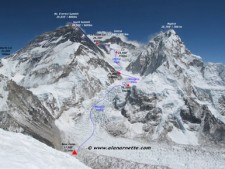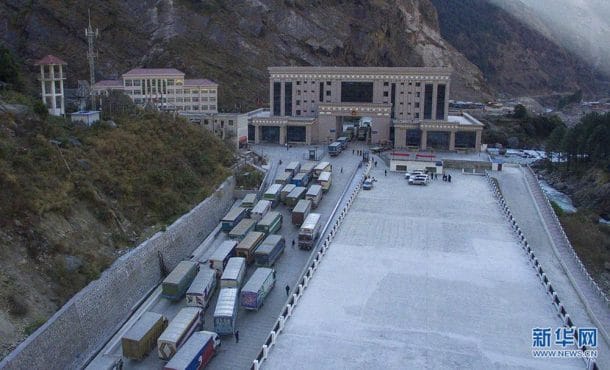While the rest of us are enjoying the holidays with family, two adventures are pushing the limits. This post is a quick look at what is happening in the mountaineering world as we close out 2012.
It was has been quite the year with a dangerous Everest season followed by deadly avalanches on Manaslu, Mont Blanc and Annapurna. It seems the world’s weather has turned ugly on the high mountains, there and is not letting up.
But that is not stopping some true adventurers.
Alone in the winter on Denali
For the third time, Lonnie Dupre is attempting a solo ascent of Mt. McKinley aka Denali in the winter. This man loves the cold and snow and it almost killed him last time out.

In 2011 he made it to the high camp at 17,200 but was stopped by high winds for six days. He returned last year and barely lived after being stranded in his snow cave at the 14,200′ camp for a week. On his website, Durpee explains why:
For as long as I can remember, I have loved snow and ice. As a result, I have spent most of my life exploring the Arctic region. These journeys have brought such joy and beauty to my life that I have dedicated myself to helping preserve these wonderful frozen places.
He climbs to bring awareness to the plight of the polar regions saying:
I am launching One World Endeavors (OWE) — a means for us to work together to inspire worldwide movements dedicated both to fighting pollution and to addressing climate change. OWE will also be a support tool for leading environmental organizations and legislators who want to inspire large audiences to help with this work.
He has spent the last several weeks here in Colorado training for Denali, finding the altitude of the 14ers a good place to test gear and his condition.
Making a winter summit of Denali is tough. The first successful summit was on March 7, 1967 by Dave Johnston, Art Davidson and the late Ray Genet. One of their teammates died in the attempt on the eight man team. They reported wind chills below -148F. In 1988 the first successful solo climb was done by Vern Tejas. As of 2012, only 16 people have made a winter summit.
From his website, Dupre details his plan including using 14-foot aluminum poles to pull a 5-foot sled and a backpack, a total weight of 225 pounds. To manage the dangerous crevasse crossings, he will use the poles plus extra-long skis.
Once he reaches the Ranger Camp at 14,000 feet, he will switch to crampons and a backpack. He plans on a eating food that mostly does not requiring cooking to save fuel weight, but still consuming over 5000 calories each day.
Dupree will not use tents but rather will build snow caves which are warmer and more sturdy, and again reducing his load. He expects 100 mph wind and -60F temperatures. Remember he will be climbing in the coldest and darkest part of winter.
He plans on arriving in Alaska around December 28th and start his climb on January 2, 2013. Follow him on his site.
winter Biking to the South Pole

How do you trump skiing to the north pole, south pole and summiting Everest all within 12 months? How about riding a bicycle to the South Pole? That is exactly what Eric Larson is up to right now.
Larsen is now on the ice pushing hard to stay on schedule. His plan is to ride nearly 750 miles from Hercules Inlet to the Geographic South Pole. If all goes well, he wants to return via the same route.
In 2009, he completed the same route in 51 days using skis. This time he believes it will take about 22 days one way.
Calling his adventure, Cycle South, his stated goal is to “combine adventure and advocacy to demonstrate the many ways in which people can use a bicycle to protect our environment as well as improve the quality of our lives.”
Larsen says the terrain in Antarctica is relatively conducive to snow bike travel as the snow is dense and compact. However he anticipates storms that will deposit large quantities snow which can create debilitating pockets of soft powder. Also, he will encounter crevasses, whiteouts and sastrugi – sharp irregular grooves or ridges formed on a snow surface by wind erosion.
Eric is heavily sponsored and is quite diligent about mentioning them in every post. He will use a Surly Moonlander bike with five inch wide low-pressure tires to provide float and traction over the snow and ice. He is carrying all his gear in specially designed panniers.
You can follow Eric on his site.
Update:
Eric has turned back per a December 28 post on his site:
However, as I started to calculate my mileage south of 85 degrees, I realized that due to an increased amount of climbing, headwinds, and consequently sastrugi and drifts, my daily mileage would realistically be closer to 10 nautical miles per day. At that rate, my chances of making the pole before my food ran out (as well as the end of the season) would be zero – odds that would basically mean a costly extraction by ALE somewhere before the pole.
But I really like what Eric had to say about this move as he keeps it in perspective:
But at least I CAN turn around. My dad and all the other people suffering with Parkinson’s Disease have no other choice but to continue forward day after day, year after year. Understanding this simple fact seemed to put my whole expedition into perspective as well as the real goal of this trip: to help raise awareness for the groundbreaking research that is being done by the Davis Phinney Foundation and their efforts to use bicycles to help improve the lives of those who live with Parkinson’s. Please donate here: www.davisphinneyfoundation.org/giving/donate/
winter Ascent of Nanga Parbat – The Killer Mountain
For a somewhat more traditional adventure, if this can be called that, is the Hungarian – American winter Nanga Parbat Expedition currently underway. The 26,600 foot, 8126 meter mountain, located in Pakistan, is known as one of the most difficult in the world.
David Klein (Hungarian), Zoltan Acs (Hungarian), and Ian Overton (American) will attempt to be the first to summit Nanga Parbat in the winter. They will not use porters, Sherpas or supplemental oxygen.
They arrived in Islamabad today and hope to be on the glacier near the mountain by January 4, 2013.
You can follow them on their site and on Facebook
Weather Woes
We are in the height of the Southern Hemisphere climbing season with Aconcagua taking center stage. Unfortunately, the weather has proven to be extremely difficult this year with extremely high winds forcing more than the usual number of private, independent and commercial expeditions to stall out. Many reached the camps above the normal base camps only to turn back due to the winds. As I have often said, Aconcagua is one of the coldest climbs I have ever experienced so pushing in hurricane winds is not smart.
Meanwhile, after a tough start to the Vinson season in Antarctica, the weather has calmed a bit and there have been many successful summits thus far.
Everest View
 If you are an Everest fan you have already seen this, but it is worth mentioning again. Climber, and of Everest IMAX fame, David Breashears now runs GlacierWorks to bring awareness to receding glaciers.
If you are an Everest fan you have already seen this, but it is worth mentioning again. Climber, and of Everest IMAX fame, David Breashears now runs GlacierWorks to bring awareness to receding glaciers.
Breashears and team created an amazing series of glacier images by stitching multiple images taken with high quality camera and zoom lens. The image in this link was taken from near Camp 1 on Pumori in spring 2012.
Switch to the full screen mode and zoom in to visit base camp, you can see Everest MD’s medical tent in the center. Himex’s camp is the first large set of tents and IMG’s is two up from them. Both left of the trail. They are still on the moving ice of the Khumbu Glacier.
Now go up the Khumbu Icefall, look for climbers throughout the ice but you can see many just below the large blocks near the top. They are near the prayer flags. The hanging seracs on Everest’s West Shoulder (Icefall left) are the source of much concern these days as they do avalanche onto the Icefall.
From this angle you cannot see Camps 1 and 2 in the Western Cwm but can see climbers at the base of the Lhotse Face. Go up up the Lhotse Face where you can see tents and climbers off center to right from the second large rock. The line going lower right to upper left are tracks crossing the Yellow Band. Lhotse’s summit is clear and the route follows the gully.
From this angle you cannot see the South Col aka Camp 4 or the Balcony but you can see the South Summit and Hillary Step and final “gentle” slope to the summit.
Look left of Everest’s summit and down the ridge-line to see tiny climbers coming up from the North Col just beyond the clouds near the saddle. Probably Sherpas setting up the high camps for the north side.
Tribute to Maurice Herzog
Legendary French Alpinist, Maurice Herzog, died on December 13, 2012 at age 93. He was the first man to climb an 8,000-meter Himalayan peak, Annapurna, despite losing all his fingers and toes to frostbite. His book, Annapurna, became must reading for anyone interested in climbing.
The Alpinist website has a nice article.
Climb On!
Alan
Memories are Everything
Sorry, there are no polls available at the moment.




4 thoughts on “Climbing News: Alone on Denali, Biking the South Pole, winter Naga Parbat – updated”
Quite a little thought provoking test. Happy New Year Allan
In all the materials I’ve seen posted on Everest, I have never seen an image this exceptional. I was mesmerized scanning for climbers and I must say the view up the Lhotse face had me questing why I ever did that! Remarkable! Alan, all the articles were fabulous and as always, I read every word. You give us a glimpse of adventure that few are fortunate enough to ever experience. Wow!
Hi Alan
Just a remarkable image on David Brashears site of Everest. Thanks so much for giving us a head’s up on that. Wow.
Happy new year to all who read Alan’s pages!
Thanks Allan, I cannot imagine climbing Denali in the Winter. He starts the day we fly back to Fairbanks. Barbara Hearty Marr David Long
Comments are closed.